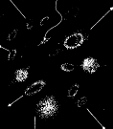Multiple Response
Identify one
or more choices that best complete the statement or answer the question.
|
|
|
1.
|
In the 1950s we discovered massive celestial
objects emitting exceptionally large amounts of energy. We call them quasars, and they are huge black
holes in the center of early galaxies with superheated gases jetting out from them along with radio
waves.
(Multi-Select
Question)
At a science conference you are challenged to construct an explanation using
cause and effect connections about how quasars support the Big Bang model.
(Select 2 of 5
choices).
|
|
|
2.
|
The Law of Universal Gravitation states that
gravity is a force that affects all matter in our Universe.
Multi-Select
Question
What evidence supports this law in connection with
the Big Bang model? (select 3 of 5 questions.)
|
|
|
3.
|
Scientists use both ground-based telescopes and space-based telescopes (in
orbit) to examine celestial objects. Ground-Based Telescopes | Space-Based
Telescopes | | | | |
Multi-Select
Question
Identify cause and effect relationships that explains why space-based telescopes
have significant advantages over ground-based telescopes (Select 3 of 5 choices)
|
Multiple Choice
Identify the choice
that best completes the statement or answers the question.
|
|
|
4.
|
Observations have revealed that the speed of light is the same throughout the
universe, and we have measured the speed of light as 300,000 km/s (186, 000 miles per second).
Furthermore, a light year is the distance light travels in 365 Earth day, and we have observed
galaxies that are billions of light years away from us.
How does our understanding of the
speed of light support the Big Bang model?
a. | Modern technology allows us to travel faster than light to examine the early
universe. | b. | This cosmic speed limit explains how gravity formed the first
galaxies. | c. | Due to this speed limit, we can look back in time to see how the universe
formed. |
|
|
|
5.
|
NASA has sent numerous robotic probes to Mars and
throughout our solar system.
What is the advantage of sending robot
probes instead of humans when exploring Mars and other distant locations in our solar
system?
a. | With current technology, the missions are
dangerous/hazardous to human life. | b. | Humans are more intelligent and perform more
complex experiments than robots. | c. | Robot technology is highly advanced, and robots
can explore better than human beings. |
|
|
|
6.
|
Edwin Hubble discovered that bright objects in the night sky were actually
galaxies far away from and separate from our own local configuration of stars called the Milky Way.
He also discovered that the great majority of these galaxies were red shifted. This provided strong
evidence for the inflation model (Big Bang theory).
According to Hubble’s law, the
farther away a galaxy is,
a. | the faster it is moving toward us. | b. | the slower it is moving away from
us. | c. | the faster it is moving away from us. |
|
|
|
7.
|
The following diagrams show stages of the universe’s formation per the Big
Bang Theory. | 1st Stage
| 2nd Stage | 3rd Stage | | |  | | | |
One supporting piece of evidence that strongly supports the Big Bang
model is how wavelengths of light from galaxies moving away from our solar system (see stage three
above) are observed to be...? a. | longer than normal (red shift) | b. | longer than normal (blue
shift) | c. | shorter than normal (blue shift) |
|
|
|
8.
|
According to the Big Bang model, during the early stages of the formation of the
universe, before stars and galaxies formed, the universe was very dense, extremely hot, and
filled with a uniform glow from a white-hot hydrogen plasma. Scientists predicted that this radiation
should be still be observable, and this was confirmed in 1948 by Ralph Alpher and Robert
Herman. How did the discovery of
this cosmic background radiation support the Big Bang Theory?a. | If the universe was compacted into a small area in the past, it must have been very
hot. This radiation is what remains from this extremely hot period. | b. | If there is
radiation from space impacting our solar system, this could explain the formation of the Sun, the
Earth, and the Moon. | c. | Cosmic models such as the Steady State theory
and the Inflation theory postulate that the early universe mostly contain a wide range of radiation
types. |
|
|
|
9.
|
The Hubble space telescope was placed in
Earth’s orbit in 1990 by NASA’s space shuttle.
Space Shuttle | Hubble Telescope | | | | |
Since ground-based telescopes are much
less expensive, what was the main reason for placing this telescope in space.
a. | Space shuttle crews needed practice placing satellites in orbit around our
planet. | b. | Outside of Earth’s atmosphere, telescopes can produce more and much better
images. | c. | The Hubble telescope was a novelty experiment paid for by
donations. |
|
|
|
10.
|
According the Big Bang model, none of the elements
shown below could have existed during the early stages of the formation of the universe.
Identify the cause and effect connection
that supports the previously given statement concerning these three elements.
a. | Cause: Sodium atoms contain 11 protons and have an atomic
mass of 23.0.
Effect: Therefore, sodium atoms also have 11 electrons in their electron
shells. | b. | Cause: Hydrogen, the most simple of all elements, was the
first atom formed.
Effect: Gravity in stars formed all later atoms starting with hydrogen, then
helium, etc. | c. | Cause: Mercury is a
metal with an atomic number of 80.
Effect: It was too hot for metals to exist in the early
universe. Only gases existed. |
|